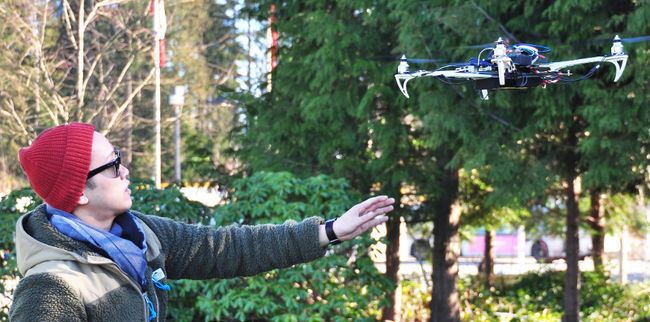Students develop cheap 3D printed Security drone that connects to WiFi and radio networks

That 3D printing technology is perfect for making fun but very functional quadcopters and other aircraft, is hardly a secret. Web forums are slowly filling up with available free designs, so be sure to look around if you’d like to make one. However, most of quadcopters are very basic models fit for racing and playing, and little else.
But, as four students from the Simon Fraser University in Canada illustrate, that same technology can be used for so much more. Thanks to just a few modifications, they have turned 3D printed quadcopter technology into highly functional drones that can be used in emergency situations such as natural disasters, missing persons or even terrorist attacks. In fact their Avian, as they’ve dubbed it, is so adept and multifunctional, that their University’s security team is planning to deploy them.
The four students from Avian Robotics have come together from all over world, united by their love for practical next-generation technology: Mark Anthony Wijaya (Singapore), George Xu (a Canadian born in Shanghai), Shakir Ali (India) and Akshay Budhiraja (Qatar). Together, they have designed and perfected the Avian, a very small web-driven drone that is no bigger than the width of a doorway. Its current design enables it to autonomously fly for twenty minutes at a time, though the following prototype will hopefully manage to stay up for up to thirty-five minutes per session.

As they explain, the biggest difference with conventional quadcopters is its connectivity. "The big difference with our drone is that it is connected directly to the Internet via an existing WiFi infrastructure, so we are essentially turning a toy into a tool," Wijaya argues. "We've created a complete cloud-connected surveillance system, and our auto pilot drones fly autonomously via pre-programmed and randomized routes." All the while, it is streaming high-quality images to its users.
But perhaps most impressive, is that this drone can continue its mission even when the internet runs out, as it can also work through LTE and radio networks. "If communications are down, they can still scramble our drone and have livestreaming coverage with instant information right away," said Wijaya.
Of course, drones of all shapes, sizes and abilities already exist in abundance, but while a similarly-functioning military grade drone will cost you at least $60,000, the Avian cost about $500 to design. The secret is, as you might’ve guessed: 3D printing. "The 3D printing process significantly reduces the price.Now with 3D printing we can easily prototype and make something quickly at a very affordable rate," Wijaya said, expecting that its price will even go down further.

Aside from monetary concerns, 3D printing is obviously also enabling the team to easily modify and customize their drones before sending them up into the air. "It is very customizable, very modular," Wijaya tells reporters, revealing that their focus on security situations is just the result of their own focus, and arguing that its same functions can be used for a number of other situations as well. "It provides an aerial view. If you are walking into an area that is hazardous you can only see what is in front of you. With aerial coverage you can see everything that’s happening around you."

While still a prototype, the Avian has already attracted the attention of Simon Fraser University’s security department. "This is pretty cutting edge technology for the security industry, and it’s an idea we’ve been contemplating for some time," says SFU’s director of security Steve MacLean, who has joined the group as an advisor on specific security applications. "These students are active and enthusiastic across their disciplines, and a good fit."
Together, they are optimizing the Avian’s designs. "We want to make it more polished before we put it out to security firms," Wijaya says. And then hopefully, after a couple of prototypes, it can be commercially marketed as an affordable security drone.







